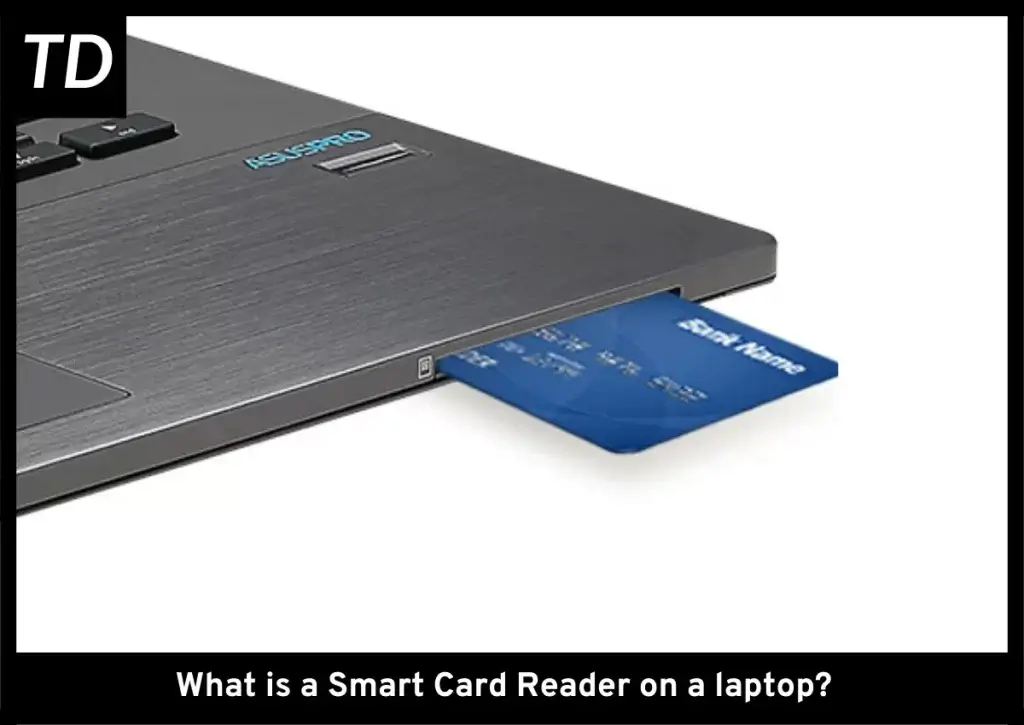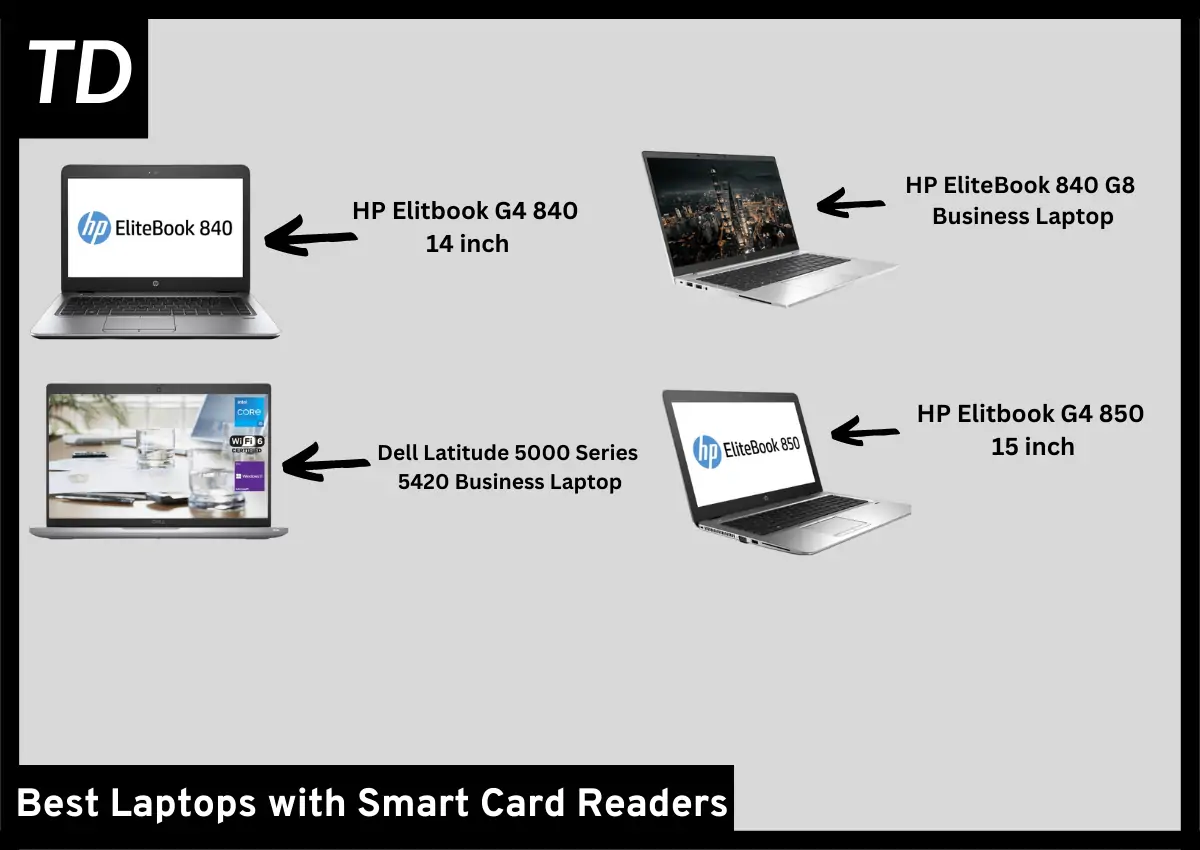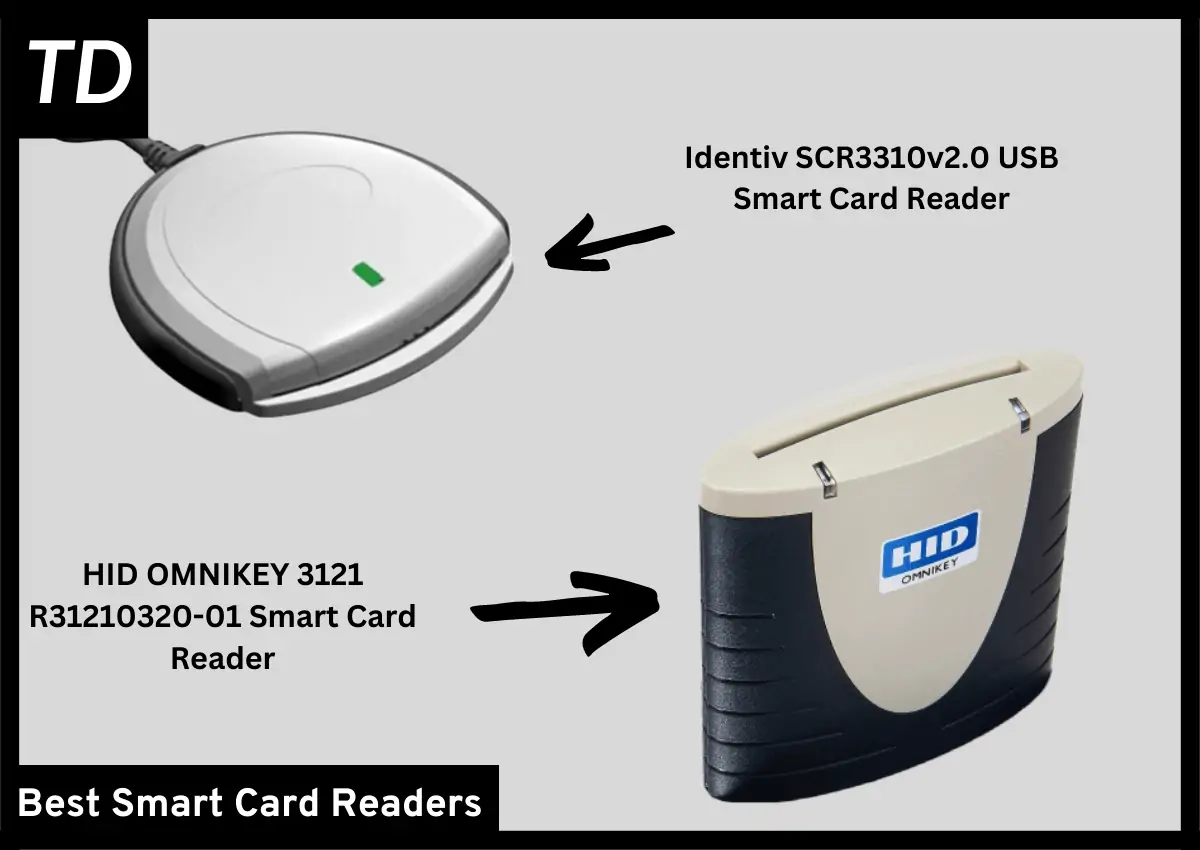A laptop’s smart card reader is a hardware component that allows a user to read and write data to a smart card. A smart card is a small device, typically the size of a credit card, that contains an embedded microchip that can store and process data.
Some laptops often have a built-in smart card reader so they can be used for multiple uses, mainly authentication, though we will go into detail on what mainly smart card in a laptop is used for.
How does a smart card actually work?
Smart cards work by using embedded microchips to store and process data. When the smart card is inserted into a laptop card reader or tapped on a contactless reader, the microchip communicates with the reader to complete a transaction or authentication process.
Here’s a more detailed explanation of how a smart card works in 6 simple steps:
- The smart card contains a microchip that stores data, a processor that can process the data, and software that controls the card’s behavior.
- When the smart card is inserted into the laptop’s card reader, the reader sends a signal to the card’s microchip.
- The microchip then responds to the reader’s signal by sending back information, such as the card’s unique identification number.
- The card reader then checks the information received from the smart card against a database to verify the card’s authenticity.
- If the card is verified, the reader may prompt the user to enter a PIN or password to complete the authentication process.
- Once the authentication process is complete, the card reader may allow the user to access a secure system, make a payment transaction, or perform other functions depending on the specific use case of the smart card.
Overall, the microchip in a smart card stores and processes data, while the card reader communicates with the microchip to verify the card’s authenticity and complete transactions or authentication processes. This provides an additional layer of security and convenience compared to other authentication or payment methods.
Types of Smart Cards
Contact Smart Cards
These types of smart cards have a gold or copper contact plate on the surface of the card that is used to make a physical connection with a card reader.
The connection between the card and the reader allows for the transfer of data, power, and commands between the two devices.
Contact smart cards are commonly used for secure authentication, payment transactions, and access control systems. They are often used in the banking, healthcare, government, and transportation industries.
Contactless Smart Cars
These cards use RFID to communicate with a card reader without the need for a physical connection. The card contains an antenna that allows it to communicate wirelessly with the reader.
These sort of cards can be used on laptops with built in NFC, in case they don’t have a physical card reader.
Contactless smart cards are commonly used for payment transactions, access control, and transportation systems. They are often used in public transportation, corporate and government buildings, and events.
Uses of a Smart Card Reader in a Laptop
Two Factor Authentication
We know about two-factor authentication from using it in our phones by getting a text message or by getting an email, however, they are not as secure as using a physical key for 2FA.
Smart cards are perfect for 2FA, as they require you to have a physical key along with a typical PIN or a password. This also means that 2FA which requires a smart card is much more secure than your usual SMS or email 2FA.
And that’s one of the reasons why physical smart card 2FA is often used in large corporate companies. The companies deploy laptops to thier employees that have either a built in smart card reader or an NFC reader.
Securing Digital Certificates
Smart cards are also used to verify and authenticate digital certificates. This can be used to access secure and encrypted networks or to make secure transactions online. So if you are using a laptop
As we discussed earlier, having a physical key is much more secure than relying on online verification such as in form of SMS or email, as these can be compromised quite easily.
Used as a key for encrypted files and application
Say you have some confiential files on your laptop and want them to be only accessible via physical authentication, well, with a smart card reader in your laptop, you can do that.
This means that one can only access specific files if the user owns the physical key.
This significantly decreases the chance of a file or an application being accessed by someone random and makes the said file or app much more secure.
This proves to be quite an effective way to secure confidential files and makes it one of the reasons why they are often used in the corporate world.
Protection of the OS
Some laptops can be configured to boot only when a specific smart card is inserted, this is undoubtedly done to increase the security of a machine and to stop any unauthorized personnel from accessing the machine.
Again, like other applications of the smart card, this is just another way to beef up the security on your laptop and reduce access to a file or a system by using the smart card reader.
Secure Payment Transactions
Using a smart card for making secure transactions is somewhat similar to how we use our debit and credit cards to make cashless payments on a POS at the general store.
When using a smart card for payment, the card is loaded with funds that can be debited as the user makes purchases or transactions.
The user can then insert the smart card into a card reader or tap the card on a contactless reader to complete the transaction.
The transaction is then authorized by the smart card’s embedded microchip, which securely communicates with the card reader to complete the transaction.
Though do note that such usecase of smart card does not exist on a laptop, as most payment gateways online support manually inputting the card details.
Advantages and Disadvantages of Using Smart Cards
Advantages
Enhanced Security
One of the primary advantages of a smart card reader is enhanced security.
By requiring both a smart card and a PIN, two-factor authentication adds an additional layer of security to sensitive information, applications, and networks.
This reduces the risk of unauthorized access and can help prevent data breaches and cyber-attacks, making your laptop much more secure.
Convenience
Smart card readers are relatively easy to use and offer a convenient method of accessing secure information.
Once a smart card is inserted into the laptop’s reader, the user simply enters a PIN to access the data.
This is often quicker and more convenient than other authentication methods, such as typing in a long password or using biometric authentication.
Though this functionality is only limited to laptops that actually have an smart card reader, and for the most part, a fingerprint reader should suffice for a normal user.
Cost-effective
Compared to other authentication methods, such as biometric or token-based authentication, smart card readers are a cost-effective solution. Smart cards are relatively inexpensive, and the reader itself is a one-time cost that can be used for multiple cards.
Versatile
Smart cards can be used for a variety of applications, such as accessing secure networks, making electronic payments, signing digital documents, and more. This versatility makes them a valuable tool for many different industries and applications.
Disadvantages
Limited Compatibility
One of the main disadvantages of smart card readers is limited compatibility. Not all laptops come with a smart card reader, and not all smart cards are compatible with all readers. This can limit the user’s ability to access secure information and may require them to purchase additional equipment or cards.
Complexity
While smart card readers are relatively easy to use, they do require a certain level of technical expertise to operate. Users who are not familiar with smart card technology may find it difficult to set up and use the reader, which can be a disadvantage in certain situations.
Cost of Smart Cards
Smart cards can be costly to purchase and replace, especially if a user requires multiple cards for different applications. This can be a disadvantage for users who need to access multiple secure networks or applications that require different cards.
Security
Smart card readers can also be subject to security vulnerabilities, such as hacking or malware attacks, which can compromise the security of the laptop and the data stored on the smart card. While these risks can be mitigated through proper security measures and precautions, they are still a potential disadvantage of using a smart card reader.
Laptops with built-in Smart Card readers:
Laptops with built-in smart card readers have become a rare breed and it’s pretty much impossible to find a new laptop with a built-in smart card reader. However, after much digging, managed to find relatively newer laptops with built-in smart card readers.
Including these laptops is the HP Elitebook 840 G8 which has a beautiful design with modern I/O like Thunderbolt, fingerprint reader, and Windows 11 compatibility.
Another option you could consider is the Dell Latitude 5420 which has a rich I/O including Gigabit Ethernet, microSD card slot along with WiFi 6 and Windows 11 support.
However, you can buy older, renewed laptops with built-in smart card readers that will serve you just fine in your daily office tasks while also being much cheaper.
We chose this HP Elitebook 840 G4 for the 14-inch, and if you want something bigger you can get the 850 G4 which is the 15 variant.
Surely these laptops don’t have modern conveniences such as Thunderbolt, high refresh displays, WiFi 6, or Windows Hello, but it still is plenty fast and we faced no issues writing this post on it, the keyboard has a short travel and feels snappy, the 1080p display looks fine enough and the overall performance is pretty good.
Smart Card readers you can buy:
In case you are looking for smart card readers for your laptop or can’t manage to find a laptop with a built-in smart card reader, then here are some of the best smart card readers you can buy:
You might also wanna read…
What is Thunderbolt? (A Detailed Explanation)



